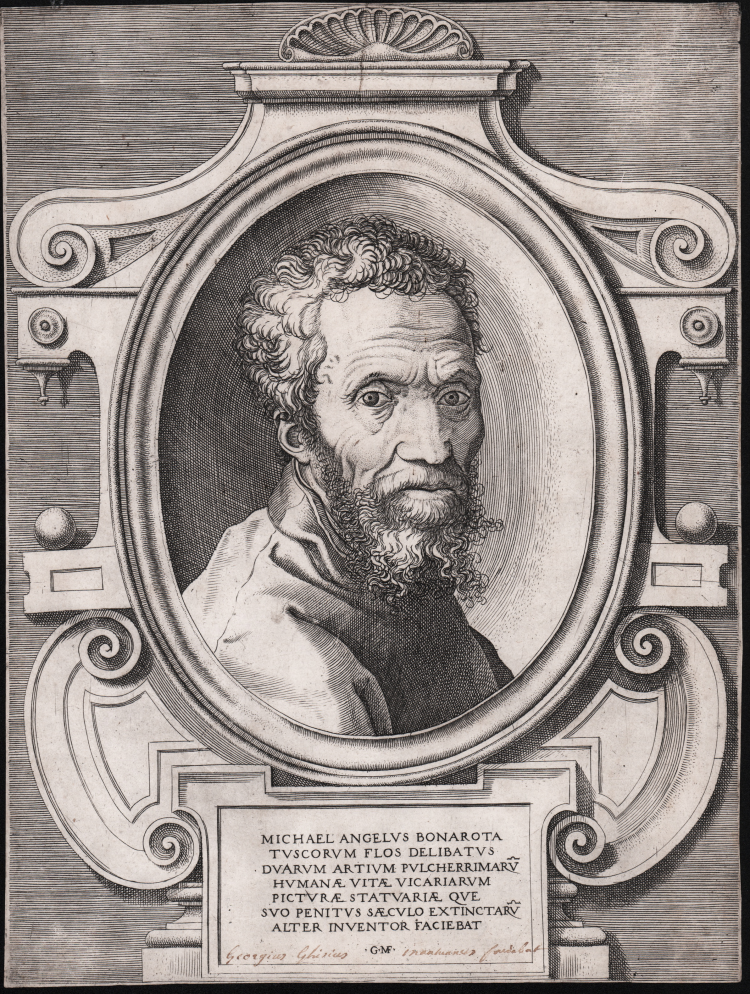




| Reference: | S43580 |
| Author | Giorgio GHISI detto "Il Mantovano" |
| Year: | 1564 ca. |
| Measures: | 200 x 265 mm |



| Reference: | S43580 |
| Author | Giorgio GHISI detto "Il Mantovano" |
| Year: | 1564 ca. |
| Measures: | 200 x 265 mm |
Bust portrait of Michelangelo facing right, set within an ornate frame, after Marcello Venusti.
Engraving, circa 1564, signed on a tablet with monogram: 'G.MF', inscribed above: 'MICHAEL ANGELVS BONAROTA/TVSCORVM FLOS DELIBATVS/DVARVM ARTIVM PVLCHERRIMARV/HUMANAE VITAE VICARIARVM/PICTVRAE STATVARIAE QVE/SVO PENITVS SAECVLO EXTINCTARV/ALTER INVENTOR FACIEBAT'
Derives from Jacopino del Conte's or Marcello Venusti's composition made after it. Both Conte's (Casa Buonarroti, Florence) and Venusti's painting (Musei Capitolini, Rome) date from c. 1545.
The engraving, however, seems to date to after Michelangelo's death in 1564. The first state of this print appears to have been printed on Northern paper (identified by the watermarks), and later on Italian paper, suggesting that the plate was transferred to Italy, where it eventually came into the hands of the de Rossi, the 17th-c Roman publishing family. The print may have been intended as a frontispiece to Ghisi's prints after the Last Judgment, copied in the 1560s, also after drawings by Venusti which were made in the early 1540s.
A very good impression, printed on contemporary laid paper with “scale in a circle” watermark, trimmed to the platemark, good condition. Inscribed at the bottom, with pen, Giorgius Ghisius mantuanus fecibat.
Bibliografia
Bartsch XV.414.71; S. Boorsch, Lewis and Lewis, The Engravings of Giorgio Ghisi, Ex Cat. New York, 1985, pp. 139-41. n. 39; Bellini, Giorgio Ghisi, 1998, n. 50 (only state)
Giorgio GHISI detto "Il Mantovano" (Mantova 1520 - 1582)
|
Giorgio Ghisi or Chizi, or Ghizi, aka Mantovano, was born in Mantua in a family from Parma who lived in Mantua between 1515 and 1525. He died in the same city in 1582.
Giorgio was paiter, carver, “operatore all’azzimina” (he worked with jewels) and engraver. His first print bears the date 1543, although it is possible that he had already started his career as engraver even before, in the school of Giovanni Battista Scultori (1503 – 1575) and working with Giulio Romano who came to Mantua in 1524 to decorate Palazzo del Tè. Giorgio left Mantua after Giulio’s death, in 1546, and he went to Rome to meet his fellow citizen Pietro Faccetti, during the pontificate of Paul III (1534 – 1549).
At the age of thirty, between 1549 and 1550, Ghisi left Italy and went to Antwerp, the most important cultural city in Europe, for he had been invited by the publisher Hieronymus Cock.
From Antwerp he moved to Paris and there he published prints form Luca Penni and Giulio Romano bearing the King’s Privilege. He remained in Paris until 1560 approximately.
In 1578 he must have engraved his last plates; we know that from that point and till his death, he worked for Vincenzo Gonzaga as jewel designer.
Bartsch and Passavant had catalogued about 70 prints, while Hubert registered just 31; D’Arco lists 44 subjects and the Lewis’ 63.
|
Giorgio GHISI detto "Il Mantovano" (Mantova 1520 - 1582)
|
Giorgio Ghisi or Chizi, or Ghizi, aka Mantovano, was born in Mantua in a family from Parma who lived in Mantua between 1515 and 1525. He died in the same city in 1582.
Giorgio was paiter, carver, “operatore all’azzimina” (he worked with jewels) and engraver. His first print bears the date 1543, although it is possible that he had already started his career as engraver even before, in the school of Giovanni Battista Scultori (1503 – 1575) and working with Giulio Romano who came to Mantua in 1524 to decorate Palazzo del Tè. Giorgio left Mantua after Giulio’s death, in 1546, and he went to Rome to meet his fellow citizen Pietro Faccetti, during the pontificate of Paul III (1534 – 1549).
At the age of thirty, between 1549 and 1550, Ghisi left Italy and went to Antwerp, the most important cultural city in Europe, for he had been invited by the publisher Hieronymus Cock.
From Antwerp he moved to Paris and there he published prints form Luca Penni and Giulio Romano bearing the King’s Privilege. He remained in Paris until 1560 approximately.
In 1578 he must have engraved his last plates; we know that from that point and till his death, he worked for Vincenzo Gonzaga as jewel designer.
Bartsch and Passavant had catalogued about 70 prints, while Hubert registered just 31; D’Arco lists 44 subjects and the Lewis’ 63.
|